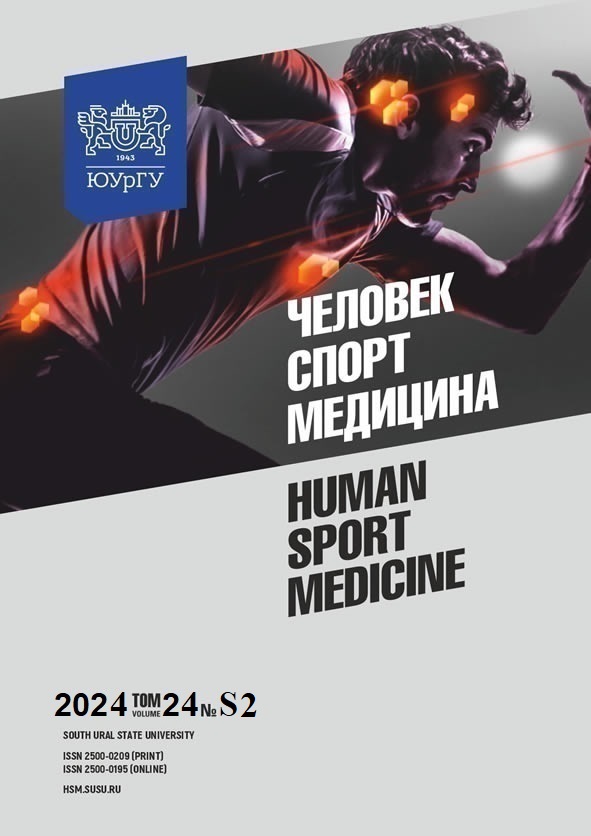ВАРИАБЕЛЬНОСТЬ ПОКАЗАТЕЛЕЙ ВЕРТИКАЛЬНОЙ РЕАКЦИИ ОПОР У ЛИЦ С РАЗЛИЧНЫМ УРОВНЕМ НАРУШЕНИЯ ФУНКЦИЙ НИЖНЕЙ КОНЕЧНОСТИ
Аннотация
Цель: выявить закономерности (особенности) данных сенсорной сети для определения дескрипторов динамического баланса во время ходьбы у лиц с различной степенью нарушения функций нижней конечности. Материалы и методы. Оценку кинематических параметров походки проводили с помощью системы захвата движения Xsens MTw Awinda и программного обеспечения Xsens MVN Analyze. Оценивалась вариабельность вариационного ряда значений вертикальной реакции сегментов нижних конечностей, определялись различия между значениями вертикальной реакции соседних сегментов нижней конечности (парный t-критерий Стьюдента), степень взаимосвязи (коэффициент r-Пирсона) между значениями вертикальной реакции соседних сегментов нижней конечности (в сенсорной сети «таз – стопа») у трех лиц, имеющих в анамнезе различные травмы нижних конечностей. Результаты. Анализ данных от сенсоров MIMU, организованных в сенсорные сети (сегменты тела: таз, бедро, голень и стопа), позволил оценить особенности ускорения (вертикальной реакции) каждого сегмента у лиц с различной степенью нейромышечного нарушения нижней конечности. Выявленные особенности представлены в качестве дескрипторов динамической стабильности нейромышечного взаимодействия соседних сегментов нижней конечности, их согласованности, выраженной в асимметричности походки испытуемых. Заключение. Установленные дескрипторы (вариабельность, согласованность, взаимосвязь) необходимо учитывать в подходах при разработке антропоморфных протезов, в программах абилитации и протезной реабилитации, а также для обучения нейросетевых классификаторов нейромышечных нарушений нижней конечности.
Литература
2. Curtze C., Hof A.L., Postema K., Otten B. Over Rough and Smooth: Amputee Gait on an Irregular Surface. Gait and Posture, 2011, vol. 33, pp. 292–296. DOI: 10.1016/j.gaitpost.2010.11.023
3. De Asha A.R., Buckley J.G. The Effects of Laterality on Obstacle Crossing Performance in Unilateral Transtibial Amputees. Clinical Biomechanics (Bristol, Avon), 2015, vol. 30(4), pp. 343–346. DOI: 10.1016/j.clinbiomech.2015.03.001
4. Demeco A., Frizziero A., Nuresi C. et al. Gait Alteration in Individual with Limb Loss: The Role of Inertial Sensors. Sensors (Basel), 2023, vol. 23 (4), art. 1880. DOI: 10.3390/s23041880
5. Fey N.P., Klute G.K., Neptune R.R. The Influence of Energy Storage and Return Foot Stiffness on Walking Mechanics and Muscle Activity in Below-knee Amputees. Clinical Biomechanics (Bristol, Avon), 2011, vol. 26 (10), pp. 1025–1032. DOI: 10.1016/j.clinbiomech.2011.06.007
6. Kamali M., Karimi M.T., Eshraghi A., Omar H. Influential Factors in Stability of Lower-limb Amputees. American Journal of Physical Medicine and Rehabilitation, 2013, vol. 92 (12), pp. 1110–1118. DOI: 10.1097/PHM.0b013e31829b4b7a
7. Lemaire E.D., Kofman J., Kendell C. Understanding Dynamic Stability from Pelvis Accelerometer Data and the Relationship to Balance and Mobility in Transtibial Amputees. Gait and Posture, 2015, vol. 41, iss. 3, pp. 808–812. DOI: 10.1016/j.gaitpost.2015.03.001
8. Lordall J., Oates A.R., Lanovaz J.L. Spatiotemporal Walking Performance in Different Settings: Effects of Walking Speed and Sex. Frontiers in Sports and Active Living, 2024, vol. 6, art. 1277587. DOI: 10.3389/fspor.2024.1277587
9. Pavei G., Salis F., Cereatti A., Bergamini E. Body Center of Mass Trajectory and Mechanical Energy Using Inertial Sensors: a Feasible Stride? Gait and Posture, 2020, vol. 80, pp. 199–205. DOI: 10.1016/j.gaitpost.2020.04.012
10. Pitkin M. The Moment Criterion of Anthropomorphicity of Prosthetic Feet as a Potential Predictor of Their Functionality for Transtibial Amputees. Biomimetics, 2023, vol. 8 (8), art. 572. DOI: 10.3390/biomimetics8080572
11. Schepers M., Giuberti M., Bellusci G. Xsens MVN: Consistent Tracking of Human Motion Using Inertial Sensing. 2018. DOI: 10.13140/RG.2.2.22099.07205
12. Simonetti E., Bergamini E., Vannozzi G. et al. Estimation of 3D Body Center of Mass Acceleration and Instantaneous Velocity from a Wearable Inertial Sensor Network in Transfemoral Amputee Gait: a Case Study. Sensors, 2021, vol. 21(9), art. 3129. DOI: 10.3390/s21093129
References
1. Эрлих В.В., Епишев В.В., Сапожников С.Б. Биомеханика ходьбы в норме и при наличии протеза ноги с использованием комплекса Xsens // Человек. Спорт. Медицина. 2023. Т. 23, № 4. С. 145–154. [Erlikh V.V., Epishev V.V., Sapozhnikov S.B. Gait Biomechanics in Normal Conditions and with a Lower-extremity Prosthesis Captured by the Xsens System. Human. Sport. Medicine, 2023, vol. 23 (4), pp. 145–154. (in Russ.)] DOI: 10.14529/hsm2304182. Curtze C., Hof A.L., Postema K., Otten B. Over Rough and Smooth: Amputee Gait on an Irregular Surface. Gait and Posture, 2011, vol. 33, pp. 292–296. DOI: 10.1016/j.gaitpost.2010.11.023
3. De Asha A.R., Buckley J.G. The Effects of Laterality on Obstacle Crossing Performance in Unilateral Transtibial Amputees. Clinical Biomechanics (Bristol, Avon), 2015, vol. 30(4), pp. 343–346. DOI: 10.1016/j.clinbiomech.2015.03.001
4. Demeco A., Frizziero A., Nuresi C. et al. Gait Alteration in Individual with Limb Loss: The Role of Inertial Sensors. Sensors (Basel), 2023, vol. 23 (4), art. 1880. DOI: 10.3390/s23041880
5. Fey N.P., Klute G.K., Neptune R.R. The Influence of Energy Storage and Return Foot Stiffness on Walking Mechanics and Muscle Activity in Below-knee Amputees. Clinical Biomechanics (Bristol, Avon), 2011, vol. 26 (10), pp. 1025–1032. DOI: 10.1016/j.clinbiomech.2011.06.007
6. Kamali M., Karimi M.T., Eshraghi A., Omar H. Influential Factors in Stability of Lower-limb Amputees. American Journal of Physical Medicine and Rehabilitation, 2013, vol. 92 (12), pp. 1110–1118. DOI: 10.1097/PHM.0b013e31829b4b7a
7. Lemaire E.D., Kofman J., Kendell C. Understanding Dynamic Stability from Pelvis Accelerometer Data and the Relationship to Balance and Mobility in Transtibial Amputees. Gait and Posture, 2015, vol. 41, iss. 3, pp. 808–812. DOI: 10.1016/j.gaitpost.2015.03.001
8. Lordall J., Oates A.R., Lanovaz J.L. Spatiotemporal Walking Performance in Different Settings: Effects of Walking Speed and Sex. Frontiers in Sports and Active Living, 2024, vol. 6, art. 1277587. DOI: 10.3389/fspor.2024.1277587
9. Pavei G., Salis F., Cereatti A., Bergamini E. Body Center of Mass Trajectory and Mechanical Energy Using Inertial Sensors: a Feasible Stride? Gait and Posture, 2020, vol. 80, pp. 199–205. DOI: 10.1016/j.gaitpost.2020.04.012
10. Pitkin M. The Moment Criterion of Anthropomorphicity of Prosthetic Feet as a Potential Predictor of Their Functionality for Transtibial Amputees. Biomimetics, 2023, vol. 8 (8), art. 572. DOI: 10.3390/biomimetics8080572
11. Schepers M., Giuberti M., Bellusci G. Xsens MVN: Consistent Tracking of Human Motion Using Inertial Sensing. 2018. DOI: 10.13140/RG.2.2.22099.07205
12. Simonetti E., Bergamini E., Vannozzi G. et al. Estimation of 3D Body Center of Mass Acceleration and Instantaneous Velocity from a Wearable Inertial Sensor Network in Transfemoral Amputee Gait: a Case Study. Sensors, 2021, vol. 21(9), art. 3129. DOI: 10.3390/s21093129
Copyright (c) 2025 Человек. Спорт. Медицина

Это произведение доступно по лицензии Creative Commons «Attribution-NonCommercial-NoDerivatives» («Атрибуция — Некоммерческое использование — Без производных произведений») 4.0 Всемирная.















